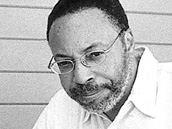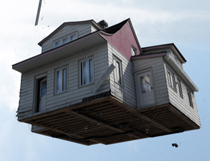The Misfits
by Serge Toubiana
London, UK: Phaidon, 2000
191 pp., $28
Sunday, the locusts
by Jim Johnstone
Toronto, ON: Tightrope Books, 2011
86 pp., $19
Published in hardcover in 2000, The Misfits, is now out in paperback. It is a stunning photo essay about the 1960 making of the last great film by Hollywood legends Marilyn Monroe, Clark Gable, and Montgomery Clift.
It opens with an interview between Misfits (1961) screenwriter Arthur Miller (famed for his plays and his marriage to M.M.) and Serge Toubiana. Next, Toubiana reviews the tortures of filming in the Nevada desert, in summer, with the shaky Monroe, the agitated Miller, the director—and inefficient perfectionist—John Huston, the morbid drunk Clift and the sickly Gable. The last section mines the archives of nine Magnum photographers, permitted to roam the set and shoot at will. The black and white snaps are excellent (perhaps better than the flick), and they gain poignancy thanks to the context that Miller and Toubiana provide.
If the movie is an elegy for wild horses (that become dog food) and the cowboy (reduced now to being just another worker in blue jeans), it is also Gable’s testament to his gifts as an actor, just as it is a revelation of Monroe’s skills as a serious – not just comedic – artist.
The film shoot itself was a version of hell. The Monroe-Miller marriage was dead; Miller loathed Monroe’s tutor Paula Strasberg; Monroe was often late for her turns; the heat was deadly; Huston kept re-shooting scenes. The movie’s theme is alienation (Miller views the actors as “several planets revolving around one another”), but that feeling itself soon infected cast and crew.
One ingenious – accidental – photo shows Monroe and Miller in a hotel room; her back is turned to him as she looks out a window, but he regards her, wistfully, tenderly. Toubiana’s essay is a meticulous consideration of the dreams and difficulties involved in making The Misfits. It is fine prose. Photographs appear throughout the book, but the final catalogue of shots is superb. Monroe is, well, Monroe. Other stars there have been; but none has been as luminous; none has the lens loved as much. Whatever she does, doffs, or dons, she is the light that the camera celebrates.
Gable incarnates weathered individualism; Clift looks sensitive, i.e., appropriately weak; Eli Wallach resembles a rough romantic; not a prizefighter, but a brawler. Huston seems thoughtful, if distracted (except when gambling); Miller seems distracted, if thoughtful (a bluesy intellectual). The shots of the desert, the horses, and the crew are just as desolate, just as splendid. Misfits is a must-read; must-see.
Sunday, the locusts is a poem composed of snippets of events, quotations, and images; it is a literary collage. But it also features many apt illustrations that are, themselves, visual collages. Authored by Jim Johnstone, a “doctoral candidate” at the University of Toronto, and illustrated by Julienne Lottering, an art history student also at the U of T, their book is dedicated to the same institution, which may explain its arch, intellectual pitch, as does the fact that the editor is Ray Hsu, a poet brilliantly studied in the academic orientation of Anglo-Canuck verse.
Johnstone summons Plato to suggest that folks are (or descend from) locusts, especially as Battle of the Atlantic sailors, (U of T) students, and urbanites (Torontonians). But a real locust infestation, of Toronto, in 1915, is also conjured. The poem’s thought is Plato, plus Darwin, plus biblical (apocalyptic) and literary allusions.
Luckily, to serve comprehension and explication, we have pages of notes. Still, a background in biology and post-modern literature – or access to Wikipedia – must be prerequisites for grappling with this self-conscious experiment. Despite his educated difficulty (cf. T.S. Eliot), Johnstone produces some effective images: “Before / flight, we were certain of a window’s strength. / Now your fist shivers through glass, wrist locked / in knots of blood, insects crowding excavation.”
It’s good, but the allusion to the Michael Ondaatje image collection alerts us to Johnstone’s debt to Coach House Press, circa 1975-85, and its publication of similar combos of word “arrangements” and Late-Late-Cubist art.






No Comments so far ↓
There are no comments yet...Kick things off by filling out the form below.